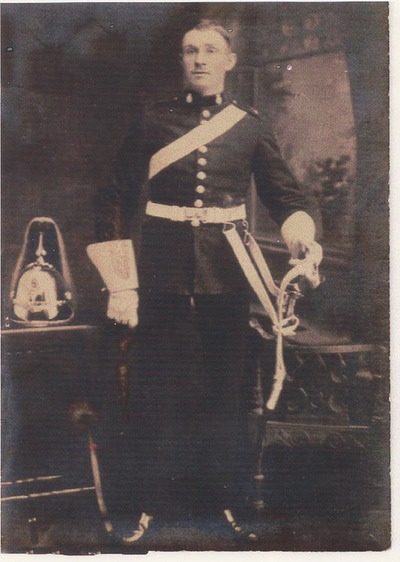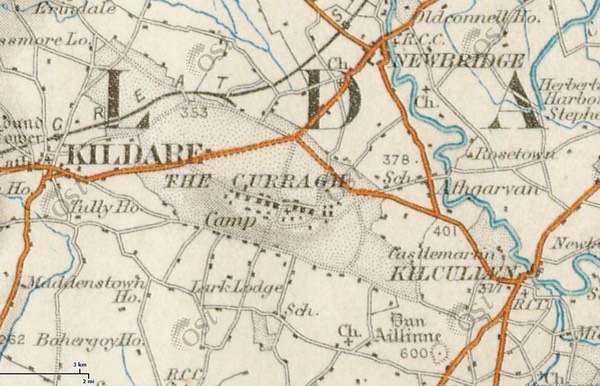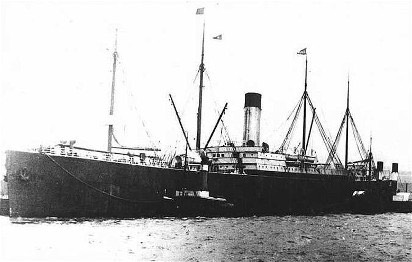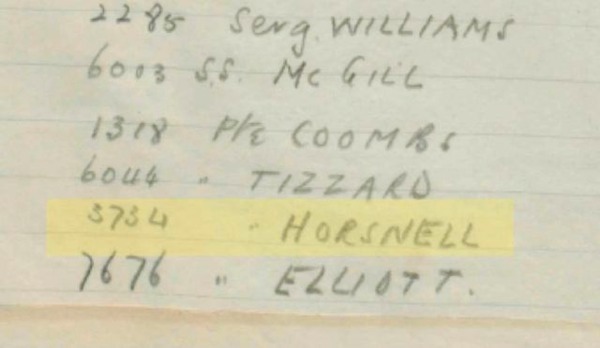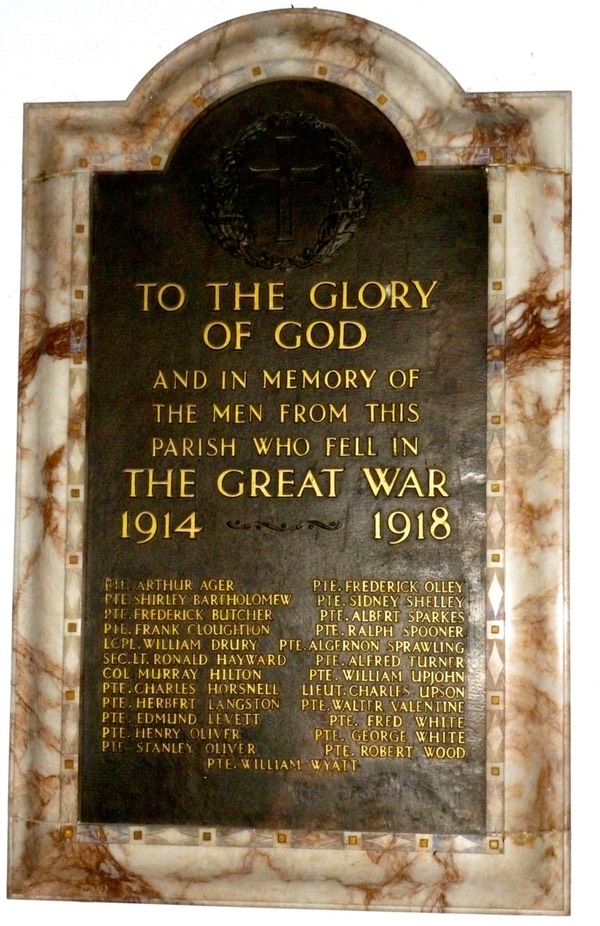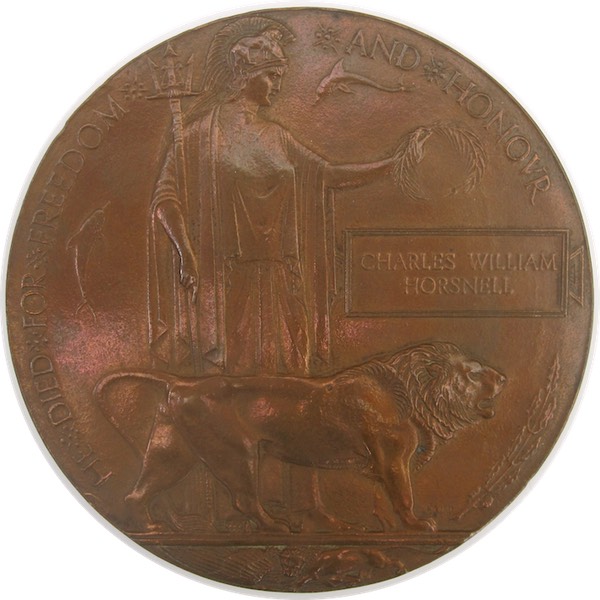Charles William Horsnell was born in 1890 in the village of Faulkbourne, near Witham, Essex. He was the first child of Alice and Robert Horsnell.
Charles enlisted at Warley, Essex, into the 5th Dragoon Guards (Princess Charlotte of Wales’s), a cavalry regiment in the British Army. His army service number was 3743, and his rank was Private.
Charles enlisted before war broke out, possibly c.1909, aged 19, becoming a regular soldier in Britain’s small, permanent standing army.
Charles's enlistment record has not survived; it may have been one of the millions of military documents destroyed in September 1940, when a German incendiary bomb struck the War Office repository in Arnside Street, London.
However, service numbers were issued sequentially, and as 3733 Private George William Brown enlisted into the 5th Dragoon Guards on 7th September 1909, just ten ahead of Charles, it seems highly probable that Charles enlisted shortly after Private Brown.
At the time of the April 1911 census, the 5th Dragoon Guards were stationed at the British Army’s Curragh Camp, County Kildare, Ireland, having been sent there in September 1910.
Charles is recorded in the Census of Ireland, 1911, together with the other men of the 5th Dragoon Guards. As was customary for residents of institutions (military barracks, prisons, workhouses, asylums, and so on), full names were not used. Instead, people were recorded by their initials only, which makes their positive identification difficult.
At the time of the 1911 census, there was a soldier serving with the 5th Dragoon Guards stationed at the Curragh Camp with the initials CWH. This man, aged 21, was born in England and his occupation was given as "labourer”. These details are a good fit for Charles, and it is highly likely they refer to him.
The 5th Dragoon Guards returned to England in October 1912, and when war began in August 1914 Charles’s story can be followed in detail from entries in the regimental war diary.
Embarked for France
The 5th Dragoon Guards formed part of the British Expeditionary Force (BEF) – Britain’s military response to the 4th August declaration of war on Germany. On Saturday, 15th August 1914, the regiment of 549 men boarded the train at Farnborough, Hampshire, arriving at Southampton at 12:15pm.
British troopship SS Cestrian, built in 1896 by Harland & Wolff, transported the 5th Dragoon Guards from Southampton to Le Havre on 16th August 1914.
She was sunk in the Aegean Sea by a Geman U-boat on 24th June 1917, near the Greek island of Skyros, while transporting troops from Salonica, Greece, to Alexandria, Egypt.
By mid-afternoon the men and their horses had boarded the troopship SS Cestrian, which departed for Le Havre, France, at 5:15am, Sunday 16th August. The horses crossed the English Channel with their saddles on, owing to the short journey. The Cestrian reached Le Havre late in the afternoon, and the regiment disembarked.
On 17th August the regiment moved out from Le Havre, taking the train to Hautmont, north-east France, from where they rode six miles to billets in the village of Colleret, close to the border with Belgium. Three days later, the regiment crossed into Belgium, to billets in the village of Villers St. Ghislain, south-east of Mons. On the way, news reached the regiment of a German advance on Mons.
From Villers St. Ghislain, the regiment rode to new billets at Audregnies, west of Mons, arriving 23rd August with a strength of 558 officers and men (some additional men had become attached to the regiment), and 524 cavalry horses. The same day, Mons fell to the advancing German force, and the BEF began to retreat.
At 5:00am on 24th August, the fast-moving German advance, stretching across a front some 25 miles wide, reached Audregnies. Charles’s regiment came under attack, and was forced to withdraw back into France.
The regiment headed south, and reached the east of Paris by early September. It then looped back on itself and moved north-east towards Reims, following which it changed course to a northerly route through Amiens, crossing back into Belgium at Dranouter on the 14th October.
The following few days saw the 5th Dragoon Guards make little progress, before the regiment arrived at Messines (Mesen), Belgium, on 20th October, where it took up positions around the town.
Battle of Messines (1914)
The German advance progressed rapidly across northern Belgium (Flanders) and north-east France, and throughout September and October both sides engaged in the Race to the Sea as they tried to break through each other’s defences, circle round and attack from the rear.
Instead of breaking through, the forces pushed each other northwards towards the coast. By November, the North Sea had been reached. Along the way, both sides had built lines of trench defences, which ran across Flanders and north-east France. The Western Front had been created.
The 5th Dragoon Guards saw action during the Race to the Sea, and by October the regiment was entrenched to the south and east of Messines.
Messines came under heavy shelling from German howitzers and was gradually reduced to ruins. On 17th November the Germans entered the town and, as the war diary of the regiment records, “throughout the day severe and uninterrupted fighting took place … A very determined attack was made at dusk”.
By the end of the day, the 5th Dragoon Guards had lost 4 officers and 27 men, one of whom was 3743 Private Horsnell, aged 24.
Fred and Arthur’s letters about Charles
Charles's younger brothers, Fred and Arthur, reached France in June and July 1915 respectively, and both wrote letters to their mother and step-father describing their search for Charles’s grave:
Fred writes:
- Before 12th June 1915: “I would like to know where Charlie got killed.”
- 12th June 1915: “When you write again, let me know the name of the place where Charlie was buried. I have forgotten what it is.”
- 19th June 1915: “I don’t think I am far away from the place where Charlie was buried.”
- 16th November 1915: “It’s a year tomorrow since he was killed. It’s nice to know that he was buried in a churchyard. You can picture his grave as one in a churchyard in England. Wherever it is possible the graves are kept up nicely. That’s one comfort for the parents to know.”
- 1st January 1916: “I saw a chap in the 5DG the other day who helped to carry poor Charlie down to the dressing station. He was hit in the head and stomach.”
Arthur writes:
- Early 1917: "There was one thing I forgot that was the name of the cemetery that Charlie was buried in so let me no when you write again.”
- Early 1917: "There is one thing you haven't told me that's were the [name] of the cemetery where Charlie was [buried]. Let me no next time you write …”
- Early 1917: “If I do get a chance of getting a piece of something off of Charlie’s grave I will. No doubt I shall before it is all over."
Memorial inscriptions
Whether Fred or Arthur actually located Charles’s grave is unclear.
Private Charles William Horsnell’s name inscribed on the Menin Gate Memorial to the Missing, Ypres.
Perhaps, when Fred mentioned Charles’s grave in his letter of 16th November 1915, it was he, a loving son and brother, who was giving “comfort” to his mother by imagining how it may have looked.
What is clear is that after the war, the Army Graves Service found no trace of Charles’s grave.
No doubt the piece of ground – somewhere in the vicinity of Messines – where he had been buried in November 1914, had changed beyond all recognition during the subsequent four years of fighting.
First World War memorial plaque, St Andrew’s Church, Hatfield Peverel. Together with Private Charles Horsnell are the names of Private Frank “Cherry” Cloughton and Private Ralph Spooner, friends of the Horsnell brothers referred to in their letters.
Instead, without a body to rebury in one of the area’s numerous war cemeteries, the name of Private Charles William Horsnell of the 5th Dragoon Guards is inscribed on Panel 5 of the Ypres (Menin Gate) Memorial to the Missing, at Ypres, Belgium – a record of 54,896 men from Britain and Commonwealth territories for whom there is no known resting place.
At home in Hatfield Peverel, Charles is commemorated on the First World War memorial plaque inside St Andrew’s Church .
Charles was one of 25 men from the parish who made the ultimate sacrifice, and amongst those listed are men mentioned by Fred and Arthur in their letters (see photo, right).
Medals and memorial plaque
Charles was posthumously awarded three campaign medals, issued to his next-of-kin (mother) between 1921 and 1923:
- 1914 Star and Clasp (“Mons Star”)
- British War Medal
- Victory Medal
Charles Horsnell’s campaign medals, each inscribed "3743 Pte C.W.Horsnell 5-D.GDS": 1914 Star and Clasp (“Mons Star”), British War Medal, Victory Medal.
The medals left the Horsnell family in the late 1970s. Their whereabouts were unknown until July 2021, when they were sold by a private collector in Bournemouth who had owned them for more than 30 years. They are currently in a private collection in North West England (August 2021).
The 1914 Star was awarded to those who served in France and Belgium between 5th August and 22nd November 1914.
Many, like Charles, took part in the retreat from Mons, hence the nickname of the medal, the “Mons Star”.
A ribbon clasp bearing the dates 5th August – 22nd November 1914 was issued to those who had been under fire during that period.
In addition to his campaign medals, Charles’s mother also received a memorial plaque inscribed with his name.
Memorial plaque with the wording 'He Died For Freedom and Honour', inscribed for Charles William Horsnell.
Made from bronze, the plaque is 5 inches in diameter, and was issued by the government in the 1920s to Charles’s next-of-kin (mother), together with a commemorative scroll from King George V.
The plaque is in the Horsnell family’s possession, having been passed down through the descendants of Arthur Horsnell, Charles’s brother.
Commonly known as a ‘Dead Man’s Penny’, ‘Death Penny’ or ‘Widow’s Penny’, due to its resemblance to a penny coin, memorial plaques were issued to the next-of-kin of all who died as a result of the First World War. More than 1 million plaques were issued.
Government payments
The government made payments to the next-of-kin of servicemen killed in action, based on their balance of pay owed. In Charles’s case the payment was divided between his mother and siblings as follows:
Balance of pay, paid 21st May 1915:
- Mother – Mrs Alice Doe: £1 4s 5d
- Brother – Frederick: £1 4s 5d
- Brother – Arthur: £1 4s 4d
- Sister – Lily: £1 4s 4d
- Sister – Dorothy: £1 4s 4d
Balance of pay, paid 16th June 1915:
- Mother – Mrs Alice Doe: £7 6s (for half-brothers and half-sisters)
After the war, next-of-kin received a War Gratuity. This was compensation based on a serviceman’s length of service, from enlistment until time of death.
War Gratuity, paid 25th July 1919:
- Mother – Mrs Alice Doe: £5
Family anecdote
During research in the early 1980s, Mrs Esther Doe (married to a half-brother of the Horsnell brothers), who was still living in Hatfield Peverel, supplied the following family anecdote:
“Charlie was killed in the 1914–1918 war and what I am now going to tell you is true. His mother distinctly heard his voice in the early hours of one morning and getting out of bed expecting him to be standing outside, but no he was not there. The next day a telegram arrived with the information that he had been killed at precisely that same hour as his mother had heard his voice."
Information request
If you have information or photographs relating to Charles William Horsnell, please use the contact form to get in touch.
Selected sources
Silver War Badge Records 1914–1920; record for 3733 Pte George William Brown, 5th Dragoon Guards (online at ancestry.co.uk).
5th Dragoon Guards, Diary of the War August 1914–April 1919 (National Archives, WO 95/1109/2).
Army Registers of Soldiers' Effects, 1901–1929; recording War Gratuity paid to next-of-kin (online at ancestry.co.uk).
Mrs Esther M. Doe, Hatfield Peverel, 11th April 1982, pers comm. Letter from a family member married to Jim Doe, half-brother of Charles Horsnell.
Mr Brian Horsnell, Barnstaple, Devon, grandson of Arthur Horsnell, October 2014, pers comm. Information regarding memorial plaque (‘Dead Man’s Penny’) and medal group.
